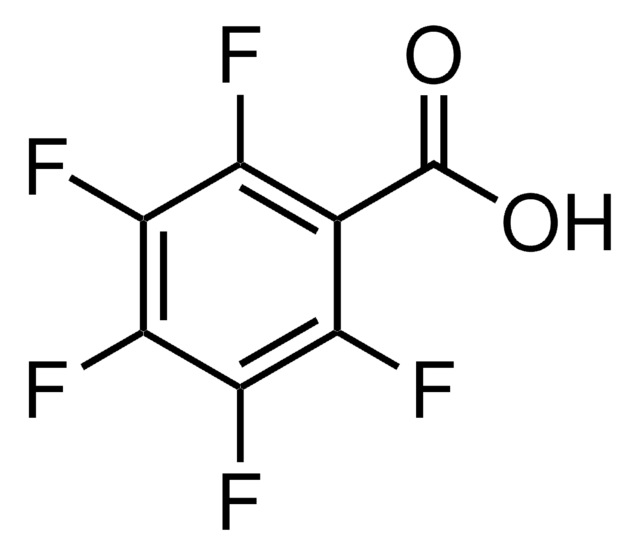38419
α-Cyano-2,3,4,5,6-pentafluorocinnamic acid
matrix substance for MALDI-MS, ≥95.0% (HPLC)
Synonym(s):
2-Cyano-3-(2,3,4,5,6-pentafluorophenyl)-2-propenoic acid, PentaFCCA
About This Item
Recommended Products
grade
matrix substance for MALDI-MS
Quality Level
Assay
≥95.0% (HPLC)
analyte functional class(es)
drugs of abuse, ionic liquids (quantification)
analyte chemical class(es)
chlorinated lipids, lipids, peptides, phospholipids, phosphopeptides
technique(s)
collision-induced dissociation MS/MS (CID-MS/MS): suitable
matrix-enhanced secondary ion MS (ME-SIMS): suitable
solubility
methanol: 100 mg/10 mL, clear, colorless to light yellow
SMILES string
OC(/C(C#N)=C/C1=C(F)C(F)=C(F)C(F)=C1F)=O
InChI
1S/C10H2F5NO2/c11-5-4(1-3(2-16)10(17)18)6(12)8(14)9(15)7(5)13/h1H,(H,17,18)/b3-1+
InChI key
LYNQRDIQUFMLTI-HNQUOIGGSA-N
Looking for similar products? Visit Product Comparison Guide
related product
Signal Word
Warning
Hazard Statements
Precautionary Statements
Hazard Classifications
Acute Tox. 4 Dermal - Acute Tox. 4 Inhalation - Acute Tox. 4 Oral - Eye Irrit. 2 - Skin Irrit. 2 - STOT SE 3
Target Organs
Respiratory system
Storage Class Code
11 - Combustible Solids
WGK
WGK 3
Flash Point(F)
Not applicable
Flash Point(C)
Not applicable
Choose from one of the most recent versions:
Certificates of Analysis (COA)
Don't see the Right Version?
If you require a particular version, you can look up a specific certificate by the Lot or Batch number.
Already Own This Product?
Find documentation for the products that you have recently purchased in the Document Library.
Our team of scientists has experience in all areas of research including Life Science, Material Science, Chemical Synthesis, Chromatography, Analytical and many others.
Contact Technical Service




![trans-2-[3-(4-tert-Butylphenyl)-2-methyl-2-propenylidene]malononitrile matrix substance for MALDI-MS, ≥99.0% (HPLC)](/deepweb/assets/sigmaaldrich/product/structures/249/587/f8021369-f65a-413d-887d-3c8a4d2a248f/640/f8021369-f65a-413d-887d-3c8a4d2a248f.png)



